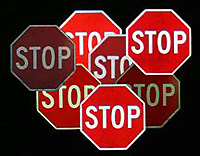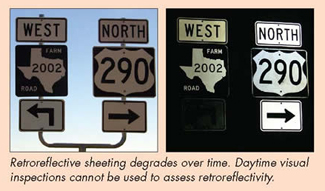
| CONNECTIONS |
IDAHO
ITD
HOME
511 TRAVEL SERVICES
IDAHO
DMV
ITD
NEWS
HIGHWAY
SAFETY
IDAHO STATE POLICE
STATE OF IDAHO
NIATT
NATIONAL
AASHTO
AAMVA
AAA of IDAHO
FEDERAL HIGHWAYS
FEDERAL AVIATION
IDAHO STATE POLICE
NHTSA
NTSB
TRB
U.S. DOT
TRANSPORTER
Archives
Milestones
Comments
Idaho
Transportation
Department
Office of Communications
P.O. Box 7129
Boise, ID 83707
208.334.8005
Fax: 208.334.8563

ITD moving forward to make highway signs
more visible to nighttime drivers
Retroreflective materials are engineered to redirect most light back toward the source. This effect gives signs a brighter appearance at night from the driver’s perspective.

Driving at night might get safer with traffic signs becoming brighter courtesy of new standards developed and adopted by the Federal Highway Administration (FHWA).
States have about 10 years to fully implement recent changes to the FHWA’s Manual on Uniform Traffic Control Devices (MUTCD) that are designed to improve the minimum retroreflectivity of highway traffic control signs.
ITD is well on the way compliance, said Carl Main, Traffic Services Engineer in the Office of Highway Operations and Safety.
“The first thing we did was to established a RetroReflectivity team comprised of Headquarters, district, and FHWA representation, and have been meeting since spring to determine what effect this will have on the department,” Main said. “As a result of the team’s work, we found we were going to be in pretty good shape.”
Retroreflective materials are engineered to redirect most light back toward the source. This effect gives signs a brighter appearance at night from the driver’s perspective.
Most signs in the U.S. are made with retroreflective sheeting materials, which degrade over time and therefore have a limited life. Sign sheeting material designs range from tiny glass beads embedded in plastic to sheeting that contains a very small complex pattern of cube corners that work like prisms.
 It has always been difficult to determine when signs need to be replaced based on retroreflectivity, so one component that will need to be included is training to identify substandard signs, Main said.
It has always been difficult to determine when signs need to be replaced based on retroreflectivity, so one component that will need to be included is training to identify substandard signs, Main said.
Even though a particular type of sheeting may meet the minimum retroreflectivity levels when new, over time it will degrade to below the minimum retroreflectivity levels. The use of higher performance sheeting, even though it has a greater initial cost, can provide a better life-cycle cost for an agency by retaining its reflectivity longer.
FHWA requires states to implement a sign assessment or management method to maintain minimum levels of sign retroreflectivity by January 2012. Three years later, agencies must replace regulatory, warning and ground-mounted signs (except street name signs) that fail to meet minimum retroreflectivity levels. By January 2018, agencies must replace street name signs and overhead guide signs deemed deficient.
The new MUTCD recommends assessment and management methods to manage sign retroreflectivity.
ITD’s Retroreflectivity Team has been meeting to come up with the department’s action plan.
“The team recommended that ITD adopt the visual assessment with a nighttime inspection option,” Main said.
ITD districts replace seven to 10 percent of installed signs each year. Main said he expects that by 2015 nearly half the traffic signs in Idaho will have been replaced through some form of attrition.
 “For the last year, our sign shop has only been purchasing prismatic material,” he said, adding that signs are installed by ITD workers or by contractors. “In our contracts, every new sign that goes up also needs to meet the new federal requirements.”
“For the last year, our sign shop has only been purchasing prismatic material,” he said, adding that signs are installed by ITD workers or by contractors. “In our contracts, every new sign that goes up also needs to meet the new federal requirements.”
New retroreflective, prismatic signs are not cheap – costing about $20 per square foot – but ITD’s replacement plan will distribute that increased expense more evenly over the coming years.
Only one-quarter of all highway travel occurs at night, according to the FHWA, but about half of traffic fatalities happen during nighttime hours.
During daylight hours, drivers have a number of visual clues, such as shoulders, pavement markings, overhead and post-mounted signs, roadside vegetation, guardrails, fences and buildings to make navigation easier. While factors like intoxication and fatigue also contribute to more nighttime crashes, darkness reduces visual cues available to drivers.
Nighttime visibility of traffic control devices is becoming increasingly important as the U.S. population ages. By the year 2020, about one-fifth of the U.S. population will be 65 years of age or older.
Older individuals tend to have reduced vision and slower reaction times. Traffic signs that are easier to see and read at night can help older drivers retain their freedom of mobility and remain independent
ITD’s Retroreflectivity Team Dave Couch, D-2 Traffic Engineer |
Published 9-5-8